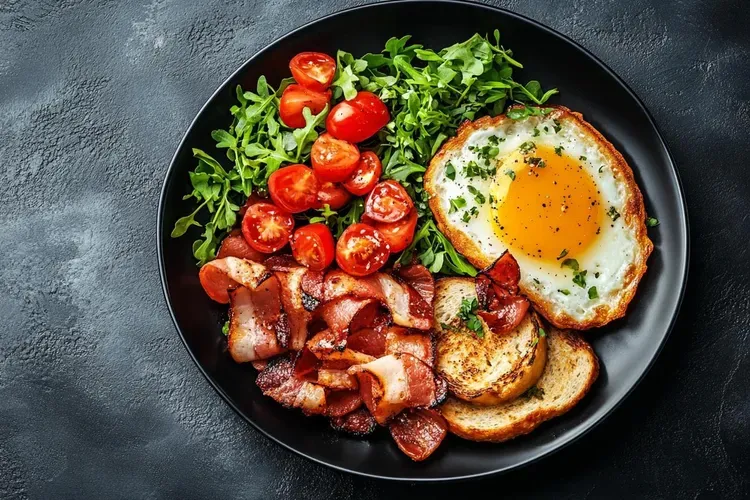How to Build a Balanced Breakfast Without Overthinking It
Starting your day with a balanced breakfast can set the tone for the rest of your day. But with so much information out there, it’s easy to overthink what to eat in the morning.

In this post, we’ll break down how to build a balanced breakfast without the stress. You’ll learn simple guidelines to follow, see examples of nutritious breakfasts, and discover common mistakes to avoid. Let’s make breakfast easy and enjoyable!
Why Breakfast is Important
Breakfast is more than just the first meal of the day; it’s your chance to fuel your body and mind for the tasks ahead. Eating a balanced breakfast can:
- Boost energy levels to help you tackle your morning.
- Improve concentration for work, school, or whatever’s on your plate.
- Support weight management by preventing excessive hunger later in the day.
Plus, it’s a great opportunity to pack in essential nutrients your body needs to thrive.
What Makes a Breakfast Balanced
A balanced breakfast includes a mix of key nutrients to keep you energized and satisfied:
- Carbohydrates: Provide energy. Opt for complex carbs like whole grains (e.g., oats, whole-grain bread).
- Proteins: Promote fullness and support muscle repair. Think eggs, yogurt, or nuts.
- Fats: Offer sustained energy and help absorb nutrients. Choose healthy options like avocado or nut butter.
- Fiber: Aids digestion and keeps you full longer. Found in fruits, vegetables, and whole grains.
- Vitamins and Minerals: Essential for overall health, sourced from fruits and veggies.
Think of your breakfast as a mini balanced plate—variety is the key!
Simple Guidelines to Follow
You don’t need a nutrition degree to build a balanced breakfast. Here’s a simple formula to keep it stress-free:
- Fill half your plate with fruits and vegetables for fiber and micronutrients.
- Add a quarter of whole grains for steady energy.
- Include a quarter of protein for satiety.
- Top it off with a small amount of healthy fats for flavor and staying power.
Or, if you prefer a less structured approach, just aim to include at least one serving from these food groups: grains, protein, fruits or vegetables, and a touch of fat.
For example:
- A bowl of oatmeal (grains) with sliced banana (fruit) and a spoonful of almond butter (protein and fat).
- A slice of whole-grain toast (grains) with smashed avocado (fat) and a poached egg (protein), plus a side of cherry tomatoes (vegetables).
Examples of Balanced Breakfasts
Need some inspiration? Here are four easy and delicious ideas:
- Oatmeal with Berries and Nuts
- Cook oats with milk or water (grains).
- Top with fresh berries (fruits) and a handful of walnuts or almonds (protein and fats).
- Whole Grain Toast with Avocado and Eggs
- Toast a slice of whole-grain bread (grains).
- Spread with mashed avocado (fats) and top with a fried or scrambled egg (protein).
- Greek Yogurt with Granola and Fruit
- Spoon Greek yogurt into a bowl (protein).
- Add a small amount of granola (grains) and sliced strawberries or blueberries (fruits).
- Smoothie with Spinach, Banana, Protein Powder, and Almond Milk
- Blend spinach (vegetables), a banana (fruits), a scoop of protein powder (protein), and almond milk (fats) for a quick, on-the-go option.
Feel free to tweak these based on your tastes or what’s in your kitchen!
Common Mistakes to Avoid
Building a balanced breakfast is simple, but here are a few pitfalls to steer clear of:
- Skipping Breakfast Altogether: Missing it can leave you sluggish and extra hungry later.
- Choosing Sugary Cereals or Pastries: They might taste good but often lack nutrients and lead to an energy crash.
- Skimping on Protein: Without it, you might feel hungry again soon after eating. Include eggs, yogurt, or nuts to stay full.
- Overdoing Portions: Even healthy foods can add up. Keep an eye on serving sizes to avoid overloading on calories.
Building a balanced breakfast doesn’t have to be complicated. By following these simple guidelines and mixing in a variety of food groups, you can start your day with a nutritious meal that keeps you energized and satisfied. Try out some of the examples above, and don’t be afraid to experiment with your favorite ingredients. The best breakfast is one you enjoy and that fuels your body for the day ahead. What’s your go-to balanced breakfast? Share your ideas in the comments below!